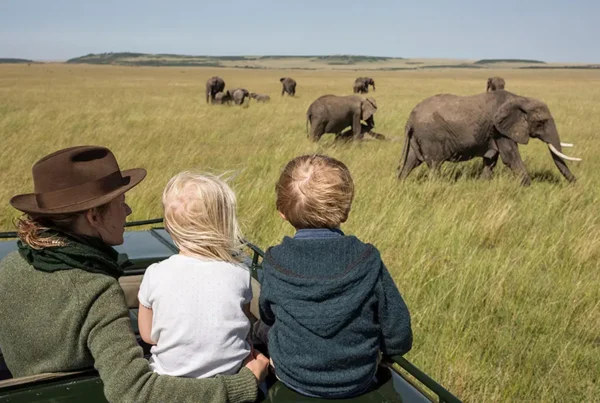Can I Combine Uganda with Rwanda, Kenya or Tanzania in One Trip? | East Africa Multi-Country Safari Guide 2026
For travelers seeking the ultimate East African adventure, the question often arises: Can I combine Uganda with Rwanda, Kenya, or Tanzania in one trip? The answer is a resounding yes. East Africa was crafted by nature to be explored as one seamless canvas — its borders drawn not by walls but by landscapes that merge effortlessly from mountain to savannah, from rainforest to ocean shore. To combine these nations is not just possible; it is the essence of what makes an African journey complete.
Each of these countries — Uganda, Rwanda, Kenya, and Tanzania — brings a distinctive rhythm and beauty to the safari experience. Uganda enchants with its emerald jungles and gorilla sanctuaries; Rwanda captivates with its tranquility and polished hospitality; Kenya thrills with its golden savannahs and iconic wildlife spectacles; and Tanzania mesmerizes with its vast horizons, from the Serengeti to Zanzibar’s beaches. When woven together, they form a journey that captures Africa’s soul in all its diversity.
However, combining multiple East African countries requires thoughtful planning, understanding of logistics, border procedures, and the unique experiences each destination offers. This detailed guide explores the how, why, and when of designing a multi-country safari across Uganda, Rwanda, Kenya, and Tanzania — ensuring that every traveler discovers the seamless harmony of East Africa without stress or compromise.
Understanding East Africa’s Geography and Travel Connectivity
East Africa’s geography lends itself naturally to cross-border exploration. The region’s major safari circuits are closely linked, with national parks and reserves often sitting along shared frontiers. For example, Queen Elizabeth National Park in Uganda borders Virunga and Volcanoes National Parks in the Congo and Rwanda, while Serengeti National Park in Tanzania merges with Maasai Mara in Kenya, forming one of the world’s most spectacular wildlife ecosystems.
Modern infrastructure, regular flight connections, and the East African Tourist Visa have made multi-country safaris smoother than ever before. The region’s governments have invested heavily in tourism collaboration, recognizing that travelers see East Africa not as a collection of borders but as a continuous journey.
Whether you prefer overland adventures that follow the rhythm of the land or quicker fly-in routes that connect distant highlights, East Africa’s accessibility ensures that a combined itinerary can be both practical and deeply rewarding. The real magic lies in the contrast — the shift from Uganda’s misty forests to Kenya’s sun-drenched plains or from Rwanda’s volcanoes to Tanzania’s sweeping Serengeti.
The Gateway: Starting in Uganda, the Heart of the Region
For many travelers, Uganda serves as the perfect entry point into East Africa. Nicknamed the Pearl of Africa, Uganda combines lush biodiversity with a central location that allows easy movement in all directions. Its international gateway, Entebbe International Airport, receives regular flights from Europe, the Middle East, and regional hubs like Nairobi and Kigali.
Uganda’s charm lies in its diversity. In a single journey, one can encounter mountain gorillas in Bwindi, chimpanzees in Kibale Forest, tree-climbing lions in Queen Elizabeth National Park, and the thunderous Murchison Falls — all within a week. Few destinations on the continent offer such range in such compact geography.
From Uganda, travelers can move south into Rwanda, east into Kenya, or southeast into Tanzania with ease. The roads connecting Bwindi to Rwanda’s Volcanoes National Park or from Kampala to Nairobi are well-traveled safari routes. Domestic and regional airlines, such as Uganda Airlines, RwandAir, and AirKenya, also link major destinations in under an hour’s flight.
Starting in Uganda allows travelers to begin their journey in tranquility, gradually unfolding the adventure from dense rainforest to open savannah, mirroring the natural transition from intimacy to grandeur.
Combining Uganda and Rwanda: The Twin Gorilla Kingdoms
Uganda and Rwanda together form the heartland of Africa’s primate experience. Separated by just a few hours’ drive, they share similar terrain, culture, and wildlife but offer contrasting atmospheres.
Rwanda, known as the Land of a Thousand Hills, is admired for its organization, accessibility, and modern infrastructure. Gorilla trekking in Volcanoes National Park is a deeply emotional experience, with short transfer times from Kigali allowing even brief visits. Rwanda also shines in cultural encounters, such as the moving Kigali Genocide Memorial, and scenic getaways around Lake Kivu.
Uganda, on the other hand, provides a wilder, more immersive gorilla experience in Bwindi Impenetrable National Park and Mgahinga Gorilla National Park. Treks here often involve deeper forest hikes, adding an element of adventure and authenticity. The encounters are equally profound, and Uganda’s slightly lower permit cost makes it a favorite for extended stays.
Crossing between the two countries is straightforward via the Cyanika or Katuna borders, which are easily accessible from both Bwindi and Volcanoes. With the East African Tourist Visa, travelers can move freely between Uganda, Rwanda, and Kenya without reapplying for separate entry permits.
A combined Uganda–Rwanda itinerary offers balance: Rwanda’s elegance complements Uganda’s raw wilderness, creating a journey that captures both refinement and adventure.
For example, one might begin with gorilla trekking in Uganda, then cross into Rwanda for golden monkey tracking or a serene lakeside retreat before flying onward to Kenya or Tanzania for classic savannah safaris.
This pairing reveals the true soul of the region — where two nations share not competition but continuity.
Combining Uganda and Kenya: From Rainforests to Great Plains
Few travel combinations encapsulate Africa’s variety like Uganda and Kenya. These two nations represent different faces of East Africa — Uganda’s lush green landscapes and Kenya’s golden grasslands. Together, they craft a story that moves from the intimacy of gorilla forests to the epic scale of the Great Migration.
Traveling between Uganda and Kenya is effortless. Daily flights connect Entebbe to Nairobi in just over an hour, operated by several carriers including Kenya Airways, Airlink, and Uganda Airlines. Overland routes via Busia and Malaba are also well-maintained for travelers who prefer scenic road journeys.
The ideal sequence often begins in Uganda, where travelers can experience gorillas, chimpanzees, and tranquil lakes, before transitioning to Kenya for the archetypal safari landscapes of Maasai Mara, Amboseli, Samburu, or Tsavo. This combination allows one to experience forest intimacy and savannah spectacle in the same itinerary.
Kenya’s cultural depth further enriches the experience. The Maasai and Samburu tribes, with their colorful traditions and connection to nature, add human warmth to the wilderness encounters. After the quiet trails of Bwindi, the sight of vast herds sweeping across Kenya’s plains creates an emotional crescendo few journeys can match.
Moreover, Kenya’s modern infrastructure and diverse accommodation options — from luxury tented camps to exclusive conservancies — make it an ideal complement to Uganda’s more rugged adventure. The synergy between the two nations defines what travelers often call “Africa in one journey.”
Combining Uganda and Tanzania: A Safari Epic from Source to Savannah
For those seeking grandeur, combining Uganda and Tanzania offers a powerful narrative — from the source of the Nile to the endless plains of the Serengeti. This itinerary captures East Africa’s ecological extremes, connecting water and wilderness in a journey that feels both natural and profound.
Flights between Entebbe and major Tanzanian hubs such as Kilimanjaro, Arusha, and Dar es Salaam are regular and convenient. Regional carriers provide easy access to both northern Tanzania’s safari circuit and southern destinations like Ruaha or Selous.
The sequence can unfold in multiple ways. Many travelers begin in Uganda, exploring Murchison Falls and Queen Elizabeth National Park before concluding with Tanzania’s iconic parks — Ngorongoro Crater, Serengeti, and Lake Manyara. The transition from Uganda’s tropical green to Tanzania’s golden expanse evokes the sensation of moving through different worlds within the same continent.
Both countries share a commitment to conservation and authentic travel. Uganda offers the intimacy of trekking — feeling the forest’s heartbeat — while Tanzania delivers the scale of cinematic spectacle, with horizons alive with migrating wildebeest and lions under acacia trees.
For a grand finale, Zanzibar’s beaches offer perfect relaxation after weeks of wilderness. The combination of Uganda and Tanzania therefore forms a journey that is both powerful and poetic — one that begins with rainforests and ends with ocean breezes.
Tri-Country Adventures: Uganda, Rwanda, and Kenya or Tanzania
For travelers with two to three weeks, a tri-country safari across Uganda, Rwanda, and either Kenya or Tanzania represents the ultimate East African expedition. Such an itinerary mirrors the natural migration of the continent’s ecosystems — from the volcanic highlands through the Great Rift Valley to the Serengeti plains.
This combination offers diversity not only in wildlife but also in experience. Uganda and Rwanda deliver the intimacy of primate encounters, where travelers walk through misty jungles in search of gorillas and chimpanzees. Kenya and Tanzania then extend the scope to vast savannahs and predator-rich plains. The contrast between quiet observation and sweeping spectacle creates emotional balance and narrative flow.
Logistically, the journey is surprisingly manageable. The East African Tourist Visa allows unrestricted movement between Uganda, Kenya, and Rwanda, with Tanzania requiring its own single-entry visa. Flights between Kigali, Entebbe, Nairobi, and Kilimanjaro are frequent, allowing itineraries to be customized for both time and budget.
A typical tri-country route might start in Rwanda for gorilla trekking, continue into Uganda for chimpanzees and Murchison Falls, and conclude in Kenya’s Maasai Mara or Tanzania’s Serengeti. Each transition enhances the story, revealing new layers of East Africa’s spirit.
This regional combination is not simply about crossing borders; it is about connecting experiences — the same sun that rises over Bwindi’s forests sets over the plains of the Mara, linking moments in one continuous adventure.
The East African Tourist Visa: Simplifying Border Travel
One of the greatest advantages of combining Uganda, Kenya, and Rwanda lies in the East African Tourist Visa (EATV). Introduced as part of regional integration, this visa allows multiple entries among the three countries for a period of 90 days.
Travelers applying through any of the participating countries can use the visa across all three without needing additional documentation. This not only saves time but also encourages seamless travel across the region. The application can be made online before travel, and processing is generally efficient.
Tanzania, while not yet part of this unified visa system, maintains simple entry procedures with single-entry visas available online or upon arrival.
The EATV has redefined cross-border travel in East Africa, aligning perfectly with the region’s vision of shared tourism and open adventure. For travelers, it represents both convenience and opportunity — an invitation to explore more deeply and freely.
Cultural and Scenic Contrasts Across the Region
Beyond wildlife, the cultural and scenic contrasts between Uganda, Rwanda, Kenya, and Tanzania elevate a multi-country journey into a living story of humanity and geography.
In Uganda, travelers encounter a warmth that feels familial — vibrant markets, village dances, and storytelling by firelight. Rwanda offers calm efficiency and emotional depth, where resilience and grace define the national character. Kenya captivates with its rhythm and energy — bustling Nairobi, vibrant coastal Swahili culture, and the open-hearted pride of the Maasai. Tanzania, meanwhile, radiates vastness and timelessness, from the ancient baobabs of Tarangire to the coral shores of Zanzibar.
The landscapes mirror these personalities. Uganda’s dense forests transition into Rwanda’s rolling hills, which then open into Kenya’s boundless plains and Tanzania’s volcanic horizons. Each border crossed feels like turning a page in a grand novel — the same story told in different dialects of beauty.
Planning Considerations: Timing, Budget, and Logistics
The ideal timing for a multi-country safari depends largely on the traveler’s interests. The dry seasons (June–August and December–February) offer the best wildlife visibility, easier trekking conditions, and clear skies for photography. These months are ideal for combining gorilla trekking in Uganda or Rwanda with game drives in Kenya or Tanzania.
Budget-wise, Uganda and Tanzania tend to offer more value for extended stays, while Rwanda and Kenya lean toward premium experiences with luxury lodges and efficient logistics. Balancing the mix ensures both affordability and comfort.
Logistically, most multi-country itineraries are built around regional flight networks and carefully coordinated ground transfers. Safari specialists, such as WildHorn Africa, tailor routes that optimize travel time without sacrificing immersion.
What makes these combinations successful is fluidity — crafting an itinerary that feels like a natural flow rather than a checklist. Each border crossing becomes a transition between moods, landscapes, and emotions.
The Spirit of East African Travel: Connection Over Borders
Traveling across Uganda, Rwanda, Kenya, and Tanzania is not simply about seeing more places — it is about understanding that Africa’s beauty transcends its boundaries. The rivers, mountains, and migration routes ignore political lines, continuing their timeless cycles as they have for millennia.
When travelers move through this region with curiosity and respect, they participate in a story older than maps — one of connection, coexistence, and continuity. Whether standing among gorillas in Bwindi, watching flamingos at Lake Nakuru, or gazing at Kilimanjaro’s snow from Amboseli, one realizes that East Africa is not a destination but a living ecosystem of wonder.
A combined safari across these nations becomes an odyssey — not hurried, but harmonious, where every sunrise marks both an ending and a beginning.
Conclusion: The Power of a Combined East African Journey
Combining Uganda with Rwanda, Kenya, or Tanzania is not just possible — it is the most rewarding way to experience East Africa. It unites primate trekking, big-game safaris, cultural immersion, and scenic majesty into one flowing journey that reflects the continent’s diversity and soul.
With well-planned logistics, regional visas, and professional guidance, borders fade into mere lines on a map. What remains is the continuity of experience — from misty forests to golden plains, from mountain gorillas to migrating wildebeest, from laughter in village markets to serenity on Zanzibar’s beaches.
For travelers seeking such a journey of connection, authenticity, and wonder, it is best to book their Africa tours and safaris with WildHorn Africa. With expert planners, regional partnerships, and deep local knowledge, WildHorn Africa ensures that every transition between countries is seamless, safe, and unforgettable.
Because the beauty of East Africa is not confined by borders — it lives in the spaces between them, waiting for those bold enough to explore them all.





 WildHorn Africa – Authentic and unforgettable tours across Africa, guided by local experts who know the land, wildlife, and culture best.
WildHorn Africa – Authentic and unforgettable tours across Africa, guided by local experts who know the land, wildlife, and culture best.


